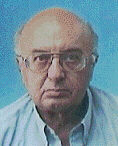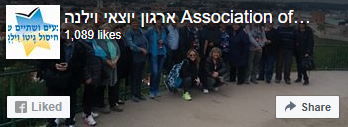Daniel Schmookler
Daniel Schmookler's story in the Vilna Ghetto - died December 2024
This is the story of how I was rescued and survived the Vilna Ghetto, against the backdrop of what happened to Vilna Jewry during the Holocaust.
Vilna was an important Jewish city, known as the “Jerusalem of Lithuania” because of its strong Jewish infrastructure. The Talmud was printed there at the Romm printing house and, even today, it is considered the definitive edition of the Talmud. The Jewish population represented a broad spectrum of Judaism. For example, the Bund (the Jewish workers’ union that advocated the integration of Jewish workers wherever they lived) was founded in Vilna. There were also many well-known rabbis, such as the Gaon of Vilna, the Hafetz Haim, and Rabbi Haim Ozer (after whom the main street in Petah Tikvah is named), who was one of the chief rabbis. There were schools where the language of instruction was Hebrew and/or Yiddish, Torah academies, many synagogues, cultural institutions, and more.
In effect, Jewish life functioned autonomously, and the Jewish community was an independent body.
At its peak, Vilna had one hundred thousand Jews. When I was born, Vilna—now the capital of Lithuania—was part of Poland. When World War Two broke out in 1939, it was occupied by Russia under the terms of the Ribbentrop-Molotov Treaty.
In 1941 the Germans invaded Russia, marking the beginning of the mass murders of the Holocaust. As soon as the Germans entered Vilna, the period of kidnappings (haphunas in Yiddish) began; Jews were abducted by the Germans with the enthusiastic help of the Lithuanian population. At first, no one understood where those taken to the Ponary Forest near Vilna were disappearing to. In the forest, pits originally prepared for fuel storage had been repurposed, and there the Jews were murdered. By September 1941, half of the Jews of Vilna had already been killed in Ponary, while the remaining twenty to thirty thousand were crammed into a ghetto.
I remember, at three and a half years old, walking with my parents, each of us carrying a bundle, as we entered the ghetto.
Later, we moved to a labor camp near the ghetto called the Kailis camp. We moved there because in the ghetto there were frequent Aktions (extermination operations in which Jews were taken out of the ghetto to be killed in Ponary). The Germans wanted to exploit skilled Jewish labor, so they decided to keep some workers alive temporarily. This camp was intended for workers in the Kailis fur factory and other factories as well. My parents worked in the leather factory, so we were transferred there.
For about a year, the Germans halted the killings and allowed us to live a more or less tolerable life, both in the central ghetto and the Kailis camp.
There were other children in Kailis, and schooling was organized for the older ones by teachers from the main ghetto. Life seemed almost normal in the central ghetto; they even staged performances (for example, the play Ghetto, which is currently being performed at the Cameri Theater).
I was four years old. I played with other children in the yard. I remember a sukkah (tabernacle) was built with a straw roof. My father worked at the factory, and later my mother did as well.
The central ghetto was liquidated in 1943, and some of our relatives managed to escape and join us in Kailis after bribing the Jewish police. These relatives, who were bakers (my grandfather was a baker), were given a basement room where they built an oven. We baked bread rolls there, and I even remember helping to punch holes in the matzot we baked at Pesach.
At this point, the Germans imposed stricter control. S.S. guards took over, blocked the gates, and increased surveillance.
One day, they announced that the children had to be brought in for medical tests. My mother was at work, so I went with my aunt, my mother’s sister-in-law. As she came up from the basement into the yard, she sensed something was wrong.
Just then, the Chief of Police arrived. My aunt quickly said: “Look, his undershirt is dirty and we are going to medical tests. I want to change it for him.” Kanterowitz, the Jewish policeman, replied: “No need.” He tried to grab me, but my aunt managed to pull me back into the room and hide me in a cranny under the oven.
I lay there for a long time, not understanding what was happening. After a while it became quiet, and I realized everyone was gone. I got up, wandered around the corridor, and, finding no one, returned to my hiding place, covering the entrance with a nearby bin.
Soon, two men entered the room and began searching. I could not see them, but I heard their voices speaking Polish or Russian. They overturned the furniture until they came across a bottle of vodka. They began to drink and eventually left. That was how I was saved from the children’s Aktion.
The “medical tests” were just a ruse; the children were taken to the Valley of Death in Ponary. In some cases, mothers went with them. The Germans searched for hidden children and assembled the adults to prevent them from interfering. It is assumed that only ten to twenty children were saved from that Aktion. A special hiding place was later prepared for the surviving children, and I sometimes hid there as well.
Later, all the men—including my father, my uncle, and the aunt who had saved me—were deported to Latvia. Shortly before liberation, they escaped from the camp but encountered Latvian partisans who, although allegedly fighting the Germans, murdered them all.
When my mother returned from work and found me alone, she shouted in Yiddish: “Where is my family?” My aunt Bella, my mother’s younger sister, came out of a hiding spot to help her care for me. I was then six and a half, and it was difficult for two women to manage with a young boy.
After the liquidation of the ghetto, the H.K.P. camp was established for Jews working in the garage workshops repairing German vehicles—workers the Germans had decided to spare. My mother had friends there, and we requested to be transferred.
Since no one knew of my survival from the children’s Aktion, I was smuggled into the camp inside a sack. The camp had two blocks and a special hiding place for the twenty to thirty surviving children. Each morning the children were taken there to stay with two caregivers until their parents returned from work.
From the hiding place window, I often watched the camp policemen. I remember seeing them escorting a collaborator named Mickey Drezin, who worked with the Gestapo and was treated with great respect.
Later, we moved to a ground-floor apartment. A few days afterward, rumors spread that the Russians were approaching. My mother and I visited her friends on the top floor. She said: “The Russians are coming, and the Germans will kill us all, so let’s hide.” They answered: “We don’t need to hide; they’ll just send us to work in Germany. But you and the boy must hide, because the Germans will kill you because of the child.”
So my mother and I went down to our room, which was at the basement entrance, and stayed there. When I told her I was hungry, she gave me a piece of bread, but I could not swallow it. It turned out there was not enough oxygen. Others also complained, and we eventually moved to the children’s hiding place I mentioned earlier. About two hundred people were crammed into two rooms.
The Germans eventually discovered the hiding place, likely due to informers. The entrance was concealed inside an oven. As people were forced out, armed Germans stood guard around the opening. I came out, followed by my mother and aunt.
While the Germans were busy searching people’s pockets, my mother and aunt dragged me into an adjoining room where we hid under beds. My mother and the other adults there soon fell asleep, and I was hidden in a cranny near the oven.
I later overheard the Germans questioning my aunt Bella, asking if she had gold. Instead of answering, she suddenly ran, distracting them and saving me from being discovered. The Germans executed her and the others in the yard, since they did not have time to take them to Ponary.
We escaped to an abandoned hut, where we waited for several days until we heard the Russian army had liberated Vilna. But our journey to Israel was still far from over.
One more memory stands out: we received an invitation to go to America, but I told my mother that I would not go there—only to Palestine. Even at six and a half, I had already decided I wanted to live in a Jewish state.
There is no true consolation for what we endured. The only small comfort is that I have a family—children and grandchildren—and that we have a state meant to protect us.
I have reflected much on what happened to us during the Holocaust, and my most important conclusion is this: “In my humble opinion, we can rely only on ourselves. We must never depend on the promises of the nations of the world. We must stand up for ourselves, everywhere and at any cost. Only then will we remain united.”
Written by Zafrira Schmookler. Published: 12/3/2012 on the Tapuz forum


